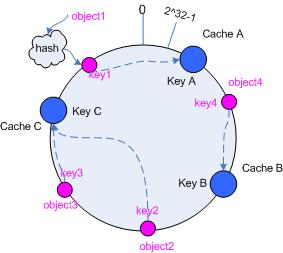一致性hash的原理 把server和key hash到同一个空间,然后同方向找最近的即可。
import java.util.Collection;
import java.util.SortedMap;
import java.util.TreeMap;
public class ConsistentHash<T> {
private final HashFunction hashFunction;
private final int numberOfReplicas;
private final SortedMap<Integer, T> circle = new TreeMap<Integer, T>();
public ConsistentHash(HashFunction hashFunction, int numberOfReplicas,
Collection<T> nodes) {
this.hashFunction = hashFunction;
this.numberOfReplicas = numberOfReplicas;
for (T node : nodes) {
add(node);
}
}
/**
* 把一个实际节点映射到多个位置上,多个位置的都指向到一个相同的节点。
* @param node
*/
public void add(T node) {
for (int i = 0; i < numberOfReplicas; i++) {
circle.put(hashFunction.hash(node.toString() + i), node);
}
}
public void remove(T node) {
for (int i = 0; i < numberOfReplicas; i++) {
circle.remove(hashFunction.hash(node.toString() + i));
}
}
/**
* 根据一个对象的key获得它的将要存储的节点
* @param key
* @return
*/
public T get(Object key) {
if (circle.isEmpty()) {
return null;
}
int hash = hashFunction.hash(key);
if (!circle.containsKey(hash)) {
SortedMap<Integer, T> tailMap = circle.tailMap(hash);
hash = tailMap.isEmpty() ? circle.firstKey() : tailMap.firstKey();
}
return circle.get(hash);
}
}
?